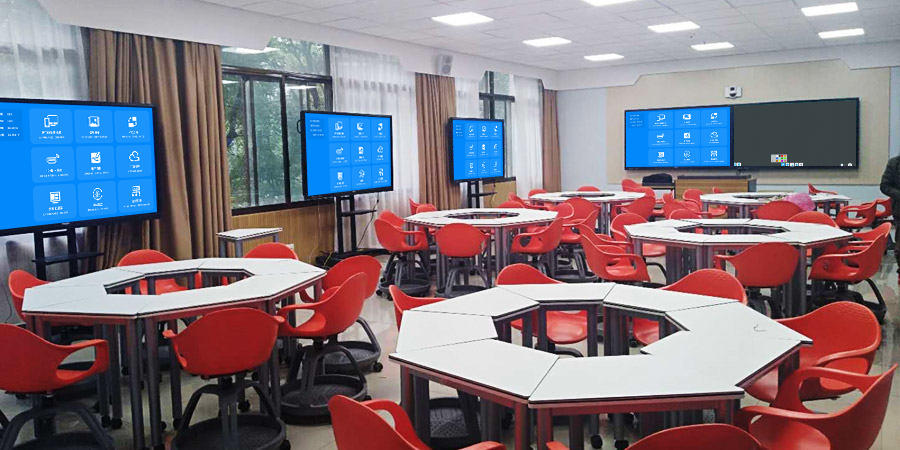Smart Classrooms: An All-Scenario Interactive Teaching Solution
The core of a smart classroom is to shift teaching from “one-way delivery” to “two-way interaction.” A solution with devices adapted for teaching scenarios can make courseware flow smoother and teacher-student interaction deeper. Based on all-terminal compatible screen mirroring technology and scenario-based function design, we can build a teaching closed loop that covers pre-class preparation, in-class interaction, and post-class extension, making smart education a reality in every class.
Pre-Class: Effortless Preparation, On-Demand Courseware
Teachers don’t need to arrive at the classroom early to set up equipment. They can use a mobile teaching assistant app to remotely wake up the classroom’s large screen and mirroring terminals. Courseware uploaded to the cloud before class is automatically preloaded by the terminal. When a teacher walks into the classroom, their phone will automatically show a pop-up window when it’s near the mirroring terminal, and they can project the courseware to the large screen with a single click. This avoids losing class time due to USB drive copying or device connection.
For group teaching needs, you can set group screen permissions in the system in advance. Different learning tasks can be pushed to each group’s split screen. When students enter the classroom, the corresponding group’s split screen already displays the task list, so there’s no need for last-minute assignments in class. This increases teaching preparation efficiency by 60%.
In-Class: Multi-Terminal Linkage, Full-Coverage Interaction
Courseware Display and Flexible Control
Teachers can flexibly control the large-screen courseware with their phones or tablets. Swiping on the phone turns pages, and the large screen responds synchronously. Circling key formulas in the courseware makes the annotations appear on the large screen in real time, with support for different colors to distinguish the annotations. If a teacher needs to add some extra knowledge, they can search for a relevant image or short video on their phone and mirror it quickly to the large screen simply by being near the terminal, without having to switch computer courseware, making the explanation more intuitive.
Even old teaching equipment can be integrated into the interaction. After connecting a visualizer, the image of the experimental setup it’s filming can be mirrored to the large screen synchronously. The teacher can then use their phone to zoom in on the details, allowing students in the back to clearly see every moment of the reagent changing color.
Two-Way Teacher-Student Interaction
Students can use their phones to scan a QR code to join the classroom interaction system. Submitted homework is automatically summarized and displayed in a split-screen view on the main screen. The teacher can click on a student’s homework to enlarge it for explanation, and the student’s phone will synchronously receive the annotated version. During a group discussion, each member can mirror their group’s mind map from their phone. After the content is displayed in a split-screen view, the whole class can compare different ideas. The teacher can use a stylus on the large screen to circle each group’s highlights, increasing the efficiency of converting discussion results by 50%.
For lab classes and outdoor practice classes, a portable mirroring terminal can be connected to a mobile screen. Students can film their own experimental process with their phones and mirror it, allowing the teacher to observe it in real time on the large screen and correct any operational problems on the spot. When multiple groups are presenting at the same time, the terminal supports a four-way split-screen view, so there’s no need to check each device individually, and guidance is more comprehensive.
Post-Class: Resource Consolidation, Extended Learning
The courseware, student homework, and teacher annotations displayed in class are automatically saved to the class resource library by the system. Students can scan a QR code with their phones to retrieve the complete content for review and can also watch a playback of the mirrored video recorded in class, so they can catch up on any missed knowledge points at any time.
Teachers can view class data through the terminal backend, such as which courseware segments were mirrored most often and common mistakes in students’ mirrored homework. This data can help teachers accurately determine the key teaching points and make their subsequent adjustments to the teaching plan more targeted.
Management and Security: Stable Support for Teaching Order
Administrators can monitor the status of all terminals in the classroom in real time through a cloud platform. If a large screen is offline or a mirroring terminal has a problem, they’ll receive a real-time notification on their phone and can complete firmware upgrades and parameter adjustments remotely, without having to check each classroom individually.
The system supports setting permissions by class time. During class, only terminals of students and teachers in that class can mirror content, preventing interference from outside devices. After class, visitor permissions are automatically enabled for other teachers to come in and collaborate. All mirroring behavior has a log, including the mirroring device, time, and a content summary, ensuring the security of teaching data.
This solution, centered on scenario-specific mirroring linkage, turns devices like phones, tablets, and large screens into “aids for teaching” rather than a “burden.” It reduces the teacher’s operational costs and significantly lowers the barrier for student participation, truly integrating the “smartness” of a smart classroom into every part of the class.